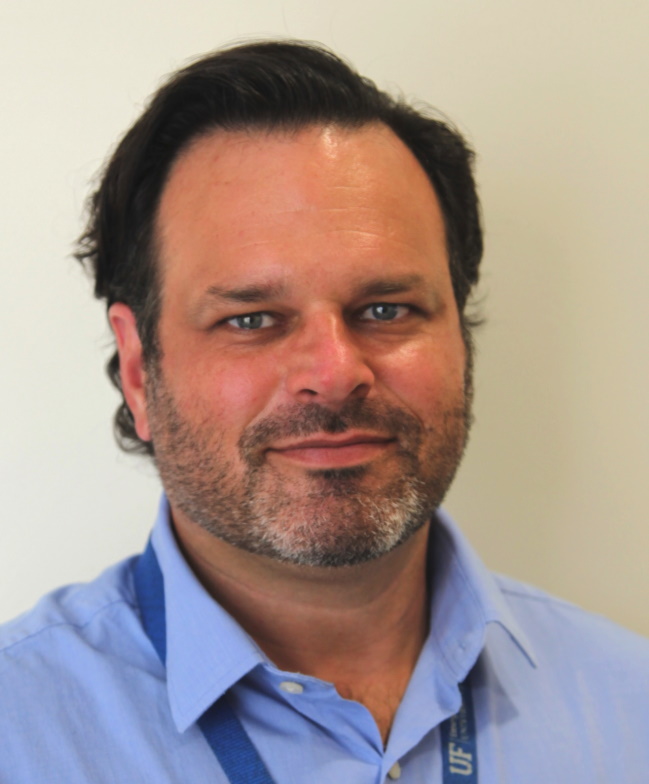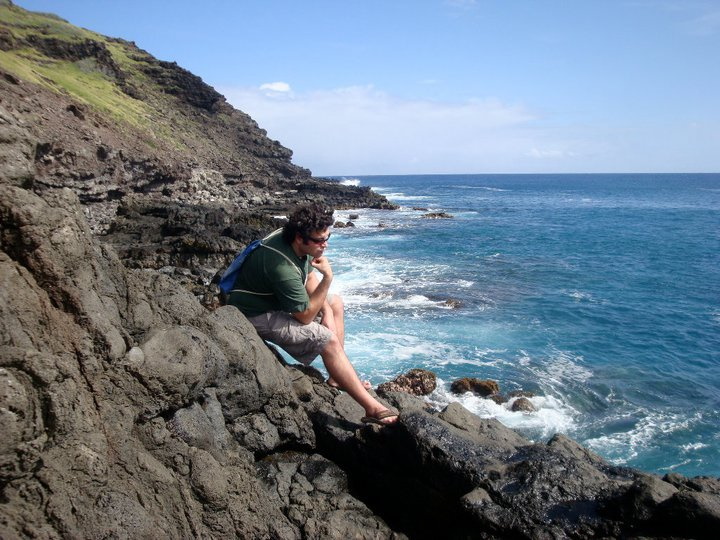
Dr. Mike Norris
Pronouns: he/him
Research Assistant Professor
Associate Director, SEER Lab
University of Florida
Focus Areas:
Research Statement: I have studied Burkholderia mallei and Burkholderia pseudomallei (the etiological agents of glanders and melioidosis, respectively) for the past 12 years at the University of Hawai’i and the University of Florida and the recent 2 year studying Bacillus anthracis and Bacillus cereus biovar anthracis. Initially I spent a few years developing genetic tools for use in Brucella spp. which cause the zoonotic disease brucellosis. I have extensive expertise in bacterial genetics, cell culture, animal infection models, gene expression techniques, pathogenesis modeling, bacterial physiology, and immunology. The past 12 years I have worked with bacteria requiring high-containment BSL3/ABSL3 facilities and published on these organisms. A great deal of my work has focused on characterizing virulence factors and assessing the downstream effects on virulence. My current research has focused on the host-responses and molecular mechanisms involved in host-pathogen interactions. These are the strengths I bring to the multi-disciplinary team of the Spatial Epidemiology and Ecology Research (SEER) Lab at the Emerging Pathogens Institute and the Medical Geography in Global Health program at the Department of Geography at the University of Florida. Our combined strengths place us in a unique situation where we have the materials, expertise, and facilities to enable important discoveries in pathogen emergence and global health.

Who is he?
Dr. Mike Norris is a Research Assistant Professor in the Geography Department and the Associate Director of the Spatial Epidemiology and Ecology Research (SEER) Lab at the Emerging Pathogens Institute. He is a microbiologist and medical geographer who conducts research on viral and bacterial diseases in a high-containment BSL3/ABSL3 facility. He is particularly interested in the spatial distribution of disease and host-pathogen interactions. As the Associate Director of the SEER Lab, Mike spends much of his time on campus at the Emerging Pathogens Institute. Prior to joining Geography, Mike spent 4 years as a Postdoctoral Associate in the Department of Infectious Diseases and Pathology in the College of Veterinary Medicine at UF.
How did he get here?
Mike grew up in the Houston metroplex suburb of Sugar Land, Texas. His family had settled in the Houston area when his Dad took a job as an Industrial Chemist, working in hazardous waste disposal and the nuclear industry. As soon as the ink on his high school diploma was dry, Mike moved to Austin where he enrolled in the University of Texas at Austin.
During a career exploration activity in cub scouts, Mike heard a nanobiologist talk about his career and was hooked. He became fascinated with DNA as a complex molecule with diverse responses. When he got to UT Austin, the Biology department was the obvious choice for him. While pursuing his Bachelor of Science, Mike discovered the wild world of infectious disease.
Upon graduating, Mike really wanted to play music, but wound up tending bar at The Atomic Cowboy Lounge for two years, before following his girlfriend (now partner) Malia to her home state of Hawai’i. Mike knew that he wanted to go to graduate school, but wasn’t sure how to get started, so he knocked on doors at the Department of Molecular Biosciences and Bioengineering, University of Hawai’i at Manoa and met his PhD adviser, Dr. Tung Hoang.
 In his first week of grad school, Dr. Hoang whisked Mike away to Thailand for a field training on handling select agent pathogens – disease organisms that pose a great risk to human and animal health. He learned practical techniques for digging up pathogens from the soil, how to process and store them, and how to prepare them for safe transport across international borders. Mike also visited hospitals where he saw patients who were suffering from some of the diseases he would study during graduate school.
In his first week of grad school, Dr. Hoang whisked Mike away to Thailand for a field training on handling select agent pathogens – disease organisms that pose a great risk to human and animal health. He learned practical techniques for digging up pathogens from the soil, how to process and store them, and how to prepare them for safe transport across international borders. Mike also visited hospitals where he saw patients who were suffering from some of the diseases he would study during graduate school.
Much of Mike’s work during his PhD focused on Burkholderia pseudomallei, the bacteria that causes melioidosis, also called Whitmore’s disease. Melioidosis or ‘The Great Mimicker,’ was originally identified in the 1920s among morphine users in Myanmar. The disease has a wide spectrum of presentations depending on the route of infection. These include bone/joint infections, acute lung infections, abscesses in various organs, and genitourinary infections. The pathogenic bacteria can live in soil and remain infectious for years. The disease began to draw scientific attention in the United States after the Vietnam War. Many helicopter pilots were exposed when they landed in fields, aerosolizing and inhaling dust and pathogens, which only manifested as an infection years later.
To safely work with Burkholderia bacteria, Mike developed a skill set for setting up and managing BSL3 labs – the only place where it’s safe to study microbes that can cause potentially lethal disease after being inhaled. The first lab Mike set up was in the University of Hawai’i’s former medical school campus – a 100 year old building that was a treatment facility for Hanson’s Disease (leprosy) sufferers. After 3 years, Mike’s lab group was able to secure space at the new medical school campus, where they were able to have modern facilities for regular experiments as well as an area for conducting animal experiments. “A large amount of paperwork and special procedures are required to operate a high-containment lab,” says Mike. “It’s all heavily regulated to make sure everyone is doing everything safely and to prevent accidental exposure to pathogens.”
 For 8 years, Mike was in the lab every morning at 7:30, often working 10 or more hours in a day. On Saturdays, he was able to sleep in for an extra half hour, before checking into the 8 AM lab reading group.
For 8 years, Mike was in the lab every morning at 7:30, often working 10 or more hours in a day. On Saturdays, he was able to sleep in for an extra half hour, before checking into the 8 AM lab reading group.
Mike was not classically trained as a geographer, but during grad school he spent 2 years as a predoctoral NSF fellow in the Interdisciplinary Graduate Education Research Traineeship (IGERT) where he studied the impact of environment and geography on human and animal health in a One-Health framework. “I never knew where I would end up,” says Mike. “Now with the increased impact of infectious disease science on Medical Geography, my unique skill set has found a calling in the Department of Geography.”
What’s he been doing at UF?
After completing his PhD, Mike moved to Florida for a postdoctoral fellowship at the University of Florida’s College of Veterinary Medicine, where he set up his third high containment lab – this time at the Emerging Pathogens Institute. After completing his postdoc work, Mike joined Dr. Jason Blackburn’s Spatial Epidemiology and Ecology Research (SEER) Lab as an Assistant Research Professor of Medical Geography. With a deep understanding of micro/molecular biology Mike’s focus is on understanding the environmental, pathogenic, and immunologic mechanisms of infectious disease. SEER Lab was just the place to explore a wide range of pathogens under a One Health framework. Recently, he started another BSL3 lab, the COVID MN Research Lab at EPI. The lab strives to understand the host-pathways required for SARS-CoV-2 infection and finding inhibitors of viral replication that could be used for treatment.
Since joining the department in 2018, Mike has coauthored 11 publications including Seroprevalence of melioidosis among swine in two Vietnamese provinces and Raxibacumab: a panacea for anthrax disease? – the latter at the invitation of the editors of The Lancet Infectious Diseases. Mike is a Co-editor (with Dr. Jason Blackburn) of the International Journal of Environmental Research and Public Health special issue: Ecology and Spatio-Temporal Patterns of Zoonotic Disease..
 Although Mike spends most of his time in the lab at EPI, he thoroughly enjoyed sitting in on GEO3454 Peoples and Plagues. As a Research Assistant Professor, Mike doesn’t have any teaching responsibilities, but he one day hopes to develop a Laboratory Methods in Medical Geography in Global Health course that would teach molecular diagnostic development, environmental sampling, and pathogen biology in a Medical Geography context. He says that without such a course, “medical geographers will have to rely on infectious disease biologists to create new assays and provide data for answering new questions.“
Although Mike spends most of his time in the lab at EPI, he thoroughly enjoyed sitting in on GEO3454 Peoples and Plagues. As a Research Assistant Professor, Mike doesn’t have any teaching responsibilities, but he one day hopes to develop a Laboratory Methods in Medical Geography in Global Health course that would teach molecular diagnostic development, environmental sampling, and pathogen biology in a Medical Geography context. He says that without such a course, “medical geographers will have to rely on infectious disease biologists to create new assays and provide data for answering new questions.“
While Mike does not currently teach courses, he is hard at work training up the next generation of scientists. He is currently supervising graduate students, lab technicians, and even an undergraduate research assistant, who may switch from a premed/economics track to formally become a Medical Geographer.
How has he been holding up during the pandemic?
Mike has a knack for working with dangerous bacterial diseases but since the pandemic, COVID research has been added to his portfolio. At first, Mike and his team were tapped to process nasal swabs for COVID screening. That quickly proved to be an underutilization of his skills and in May, he was awarded a UF CTSI COVID Rapid Response Translational Research Grant “Identification of host determinants of SARS-CoV-2 infection” to set up a COVID-MN BSL3 laboratory that has produced data for several SARS-CoV-2 funded projects across campus. This work has expanded into using CRISPR to identify druggable targets in human cells for the fight against COVID-19.
 When he’s not suited up in the lab, Mike and his family have gotten away to secluded beaches and trails here in North Central Florida, and are fixing up their house. He also likes to sprawl in the hammock with his kids, and play the guitar when he can.
When he’s not suited up in the lab, Mike and his family have gotten away to secluded beaches and trails here in North Central Florida, and are fixing up their house. He also likes to sprawl in the hammock with his kids, and play the guitar when he can.
Credit: Mike Ryan Simonovich